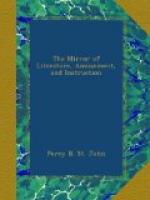J.E.
[2] See Ode to London Stone. MIRROR, No. 357, p. 114.
[3] See Shakspeare’s Henry VI., part 2, act 4, scene 6.
[4] The ancient name for London.
[5] The cause of the great plague
in 1665, was ascribed to the
importation of infected goods from Holland,
where the plague
had committed great ravages the preceding
year.
[6] Stowe in his history describes
the London Stone, “fixed in
the
ground very deep, fastened with bars of iron and otherwise,
so
strongly set that if carts do runne against it through
negligence,
the wheels be broken, and the stone itself unshaken.”
See
No. 64 of the Mirror for an account of London Stone.
[7] When the church of St.
Swithin was repaired in 1798, some of
the
parishioners declared the London Stone a nuisance which
ought
to be removed. Fortunately, one gentleman, Thomas
Maiden,
of
Sherborne Laue, interfered and rescued it from annihilation,
and
caused it to be placed in its present situation.
* * * * *
HAVER BREAD.
(To the Editor of the Mirror.)
A correspondent wishes to be informed of the definition of the word avver. In the 15th volume of the “Beauties of England and Wales,” it is alluded to thus:—“This county (Westmoreland) being supposed unfavourable to the growth of wheat, black oats, called haver, and the species of barley called bere, or bigg, were the only grains it produced. Of the haver, bread was made, or the species of pottage called hasty pudding; this bread being made into thin unleavened cakes, and laid up in chests within the influence of the fire, has the quality of preserving its sweetness for several months; it is still in common use. The bigg was chiefly made into malt, and each family brewed its own ale; during the hay harvest the women drank a pleasant sharp beverage, made by infusing mint or sage buttermilk in whey, and hence called whey-whig. Wheaten bread was used on particular occasions; small loaves of it were given to persons invited to funerals, which they were expected “to take and eat” at home, in religious remembrance of their deceased neighbour; a custom, the prototype of which is evidently seen in the establishment of the eucharist, for in this county it still bears its Saxon name, Arvel bread, from appull, full of reverence, meaning the holy bread used at the communion.”
P.T.W.
* * * * *
THE SKETCH-BOOK.
* * * * *
BATTLE OF QUATRE BRAS.




